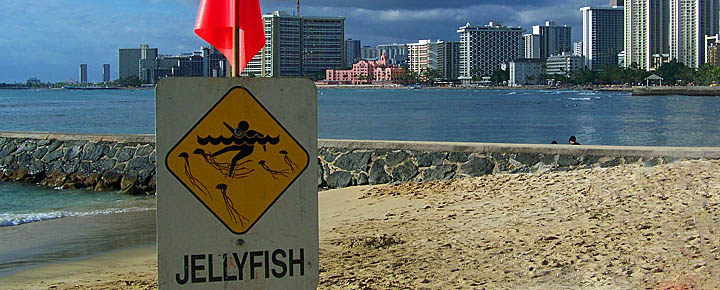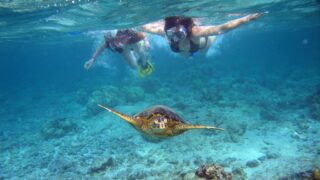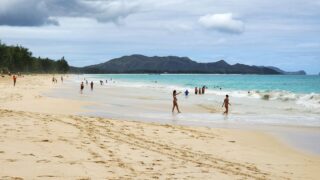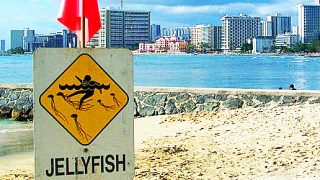Jellyfish stings happen every month in Hawaii. As one of our readers found out, you can’t rely on a well-rated resort’s staff to warn you of the hazards of Hawaii jellyfish stings.
Diane left a comment saying, “I was stung just after sunset at the Sands of Kahana beach in front of the resort, just 10 ft from the shoreline on 7/14. It stung through my one-piece bathing suit on my midriff and also my left wrist. Like a lot of bee stings, only worse. When we got back to our room, it was welting in 3 places. Luckily we had vinegar which I am applying. Security came and offered Hydrocortisone. The front desk had no idea there were jellyfish present, yet the security guard knew immediately what had happened. Apparently, the 12th, 13th, and 14th are watch days for jellyfish this month on Maui, especially on South and West facing beaches. They should have warned us, at the least!”
Global jellyfish invasions are becoming more common, even in unexpected places.
Maui hasn’t been a place where we’ve typically seen as many jellyfish issues as we do on Oahu and Kauai. But things are changing with regard to jellyfish, and that is true not only in Hawaii. Jellyfish, without eyes, spine, brain, or blood, are prolific reproducers and stingers, to be sure. Whether caused by global warming or something else, vast numbers have been coming ashore in unexpected places. They are now found in many places, including Australia, Florida, Scotland, Sweden, the Philippines, Namibia, and Ireland. The list goes on and on.
As the average surface temperature of the oceans continues to rise, jellyfish thrive. Then too, fishing has reduced the stock of jellyfish predators.
Should the resort have warned its visitors about the jellyfish?
We can’t speak for the resort as to its policy on such matters, but visitors anywhere need to take it upon themselves to become aware of hazards and take appropriate action. That includes Hawaii jellyfish stings that can occur throughout the year on a regular monthly basis. The event took place during the dates that we might have expected to encounter box jellyfish.


You can still have a jellyfish-sting-free Hawaii vacation.
If you’re headed our way later this year, below we have our updated 2023 Hawaii jellyfish sting warning calendar.
Jellyfish are mostly water.
Their venomous stingers, resembling tiny needles, are located at the tips of their tentacles. These stingers can release their toxin into victims within a millionth of a second. In Hawaii, you may encounter various jellyfish species, including box jellyfish, moon jellyfish, and lagoon jellyfish.


Why is Hawaii prone to box jellyfish invasions?
Recent research conducted over ten years at UH Manoa has shed light on this issue: It’s the “Key number of hours of darkness during the lunar cycle.” Jellyfish come to the shoreline based on the number of hours between sunset and moonrise. Thus, the lunar cycle is critical in the timing of their arrival.
Reproduction: Jellyfish come to the beach to spawn each month.
Interestingly, the jellyfish species found in Hawaii are the only ones known to exhibit this clockwork lunar spawning migration behavior. Similar species can also be seen in Key West Florida, Puerto Rico, and in Saipan.
Now, let’s focus on how you can avoid jellyfish stings – Awareness First:
Location: Hawaii’s south-facing beaches, including Ala Moana Beach Park, Hanauma Bay, Waikiki, and the Waianae Coast on Oahu, are impacted by box jellyfish for approximately eight days following each full moon.
On Kauai, Poipu Beach and Salt Pond Beach may also see jellyfish.
While jellyfish sightings on south-facing beaches of Maui and the Big Island have been less common, they do still occur, as is clear in the visitor comments today.
Timing: The prominence of jellyfish at beaches in Hawaii starts 8 days after each full moon and lasts for about three days, starting eight days after each full moon. If you find yourself on an impacted beach during this time, please check with a lifeguard for suggestions. And, if you spot jellyfish on the beach, you can virtually be sure of their presence in the ocean.
Remaining 2023 Hawaii Jellyfish Sting Warning Dates:
While jellyfish stings can happen at other times, the following dates are when problems are most likely to occur. Be on alert on the days immediately preceding and following these caution dates as well:
August 9 to 11
September 7 to 9
October 7 to 9
November 5 to 7
December 4 to 6
Treatments for Jellyfish Stings:
Regarding treatments, there are various suggestions with anecdotal evidence of their effectiveness. A simple Google search for “jellyfish sting treatment” will provide you with a plethora of suggestions.
Research indicates that some treatments may worsen the situation rather than help. For example, scraping off the tentacles, a traditional approach, can actually intensify the venom release.
Preferred remedies include rinsing the affected area with vinegar and carefully removing the jellyfish tentacles using tweezers. Heat is often suggested as more beneficial than ice for alleviating pain. Vinegar is believed to help reduce the toxin’s effects, while heat slows down the venom. Although we cannot confirm the validity of these claims, we would love to hear more of your thoughts on this matter.
Further steps to take if you encounter a jellyfish sting:
Seek medical help if severe complications or shock occur. Symptoms that can be dangerous include swelling, severe rash, vomiting/nausea, severe headache or stomach ache, respiratory issues, and muscle spasms.
Rinse the affected area with vinegar to neutralize the toxins and carefully remove any jellyfish tentacles. Some individuals suggest using ocean water to wash the area as well.
Applying heat or cold may provide relief. Alternating between the two can reduce pain severity and duration. You may want to try immersing the affected area in warm water between 104 to 113°F for at least 20 minutes. A warm shower can have a similar effect. Taking ibuprofen or acetaminophen may also help alleviate discomfort.
After Bite itch eraser stock has been a long-standing favorite for many. Composed of ammonia and baking soda, it has been used successfully for jellyfish stings, as well as bee and mosquito bites. We keep it on hand. Numerous other options are available online as well.
Mayo Clinic recommendations for jellyfish sting treatment:
Use tweezers to remove visible tentacles.
Soak the affected area in hot water (between 110 to 113°F) for 20 to 45 minutes at a time. Ensure that the water is hot but not scalding.
Avoid scraping off the stingers.
Please share your personal experiences with jellyfish encounters during your Hawaii vacations and let us know which treatment worked best for you.
Get Breaking Hawaii Travel News






Jellyfish stings yesterday snorkeling
Kaanapali in front of hanua Kai / Westin
Could not see any in the water but noticed fish feeding closer to surface
Any time you go into the Ocean you never know what’s there, always expect the unexpected. It’s not the Resorts place to watch over us. If they know there’s been a sighting of something then yes, put out notice.
One thing that seems to be overlooked when discussing invasive species, like jellyfish, is how cargo shipping is responsible for a lot of the spread of ocean going creatures.
They attach themselves to the haul, get sweep into bilge water and towed along in a ships wake. They make their way to area’s with no natural enemies and flourish.
Look at Lion fish explosion off Florida no climate change to blame here, but fish owners who’ve dumped their pet into the ocean. Or again Python population exploding in Florida from individuals letting them escape or releasing them in the everglades.
I believe it is very silly people think hotels staff are responsible for warning tourists. It’s the ocean there are things that will bite, sting and eat you. It scares me but I realize it’s my own risk. I am sure if staff was aware they would have said something. Thank you for the updated warning dates for jellyfish. Now if I can beat my fear of sharks. Lol My long awaited visit to beautiful Maui is middle of Sept. Very excited to experience new cultures.
To everyone reading these comments……this is an occasional issue in the water at Any hawaii beach during all months of the year……and is a classic Man of War Jelly fish sting. It does not happen often….but these jellies can blow in with the wind and be almost invisible. The strands can be long invisible ropes in the water and wrap around your body…….its very irritating….but goes away in a few days. These jellies are commonly blown in from the open ocean with the wind and often land on our wind facing shores……
I agree with Mike. I grew up on Oahu and I have never heard of Portuguese man -o- war jelly fish showing up in Waikiki but I am sure it happens . I have always seen them at Lanikai or Bellows Beach on the Windward side of the island. Not south facing beaches but I guess it could happen anywhere. Thanks for the heads up.
Wow I bet that hurt! I came a couple weeks ago and luckily the guys I booked my trip with were locals and gave me a heads up about the Jelly fish. I was scared at first but after they told me what hotels, beaches and side of the island I might want to avoid I felt pretty relieved. Shout out to Chris at Hawaii Tours for the warning, might have saved my whole trip!
Why is it the hotel’s fault? Are they responsible to warn customers about every single risk possible for every single activity that they might engage in while on the island? Their responsibility is lodging, who can be manned by former tourists who decided to move to Hawaii permanently and may not have amassed a healthy knowledge of the elements yet.
It should be their Own responsibility and due diligence to look up current weather and risks for wherever they go and whatever they do.
She is blaming her ignorance on the locals. A tale as old as time. If you don’t know the ocean is dangerous in many different ways then you shouldn’t go in. When you check into a hotel on Vegas do they need to warn you that there are scorpions in the desert?
I been stung at another beach resort. What bothers me the most, the resort known and doesn’t warn guests. Plus most of the staff who live on the islands I think are told to play stupid and say ( oh, we didn’t know there’s jellyfish)! If as you say it based on moon cycle, they know. They should also be prepared to help with some sort of medical care. At a minimum, vinegar. They don’t help because it becomes a libel problem.
Wow – Jellyfish stings visitor! That’s never happened before.
Slow news day?
I’m seeing flight issues, I’m Island charges to to tourists, tax increases and I don’t know how Hawaii plans to address this.
I get it. But does nobody remember COVID? Hawaii died. And now that tourism is back, I’d hope there would be an appreciation.
Hawaii didn’t die during Covid. On the contrary. Many locals showed their kids how Hawaii used to be before over tourism took over. I was in Maui during Covid and it was beautiful. I now live here full time!
When I first started going to Hawaii back in ’89 I wa swared that typically 8 to 10 days after the full moon that it is the most likely time to encounter jellyfish. I only ever had one problem outside of that timeframe. About 2 weeks after the full moon I got stung on my forehead and ex2 got a couple down the front of her bathing suit and she had a lot of flesh there. The vinegar worked well but to this day I still get a burning, itching feeling on the place it stung me. Definitely not a pleasant feeling and a lot worse than something like getting into poison ivy.
I have never, so far been stung by Jellyfish or Stingrays. And I haven’t been bitten by Sharks. I don’t go in the ocean anymore because I realize this is these creatures territory. I swim in the hotel pool. If I go on the ocean I go in a boat. That gives me a better chance. Not a 100% but better. I have seen lots of Jellyfish on the beach at Galveston, Texas. I don’t totally trust these preferred times when Jellyfish are less likely to strike because Jellyfish and the other creatures don’t have calendars and they don’t wear watches! I feel it’s safe to assume they are present in the ocean at all times. The hotel can post warnings but it’s good if the visitor does their homework before they leave home.
We visited Waimanalo and Kailua beaches during our 2 week stay in January and I do recall thinking it seemed like they (portuguese man of wars – tiny purple thumbnail size buggahs) were around for more than just 3 days as I have previously read about.
I agree, that visitors anywhere need to take it upon themselves to become aware of hazards and take appropriate action. Many tourists have no idea how to even swim and go into the ocean. Many believe it is just a fair ride and everything will be just fine. Everyone should take the time to learn the history of the water, land, and its people.
A little over a year ago we were on a sunset snorkel cruise along the Napali and while snorkeling near the cliffs several of us, including me, were stung by jellyfish, don’t know what kind. When the crew realized what was happening it was everybody out of the water. They had some vinegar, which I suppose helped some, but for the next hour or so it was uncomfortable. By the time we had returned to the dock it the discomfort had pretty much gone away. Just another adventure in Hawaii, but I’ll be fine if I don’t experience it again.
You can get stung without even being in the water. On our first trip to Australia several years ago, we thought it would be fun to walk the beach first thing in the morning right after sunrise. What could possibly go wrong….
The Hotel warned us that box jellies (the Australian variety which can pack a wallop and on occasion have caused death) will wash ashore overnight and be scattered all around the beach in the receding/receded surf line. They looked the size of half-dollars and the tentacles were not noticeable. They appeared a bit like seashells you might pick up as a souvenier. If stepped upon, you will get stung on the bottom arch of your foot, a very very tender spot. We wore closed tennis shoes, not sandals or open soled shoes of any type. Be aware, please!!! Especially kids. They love shiny things.
Also, if trying to remove tentacles, I personally would soak the location in warm/hot water before trying. Think shaving and how hot water softens the skin, it should make pulling them out completely easier. This is not medical advice, just me thinking it through. Warm skin is softer, cold skin is “tighter”. Just saying…
That was the best advice we got for the whole trip. There were little round shiny things all over the beach just asking to be picked up. (Yes, I am a diver, too, so there is some street knowledge here.)
Aloha! A visitor to West Maui, North Ka’anapali Beach to be specific was stung yesterday July 14th by a “web-like white jelly” on her left arm and upper right leg…it left a painful sting and rash all over her arm/leg. I suggested vinegar and they were able to get a small squirt bottle from the Royale Lahaina staff. I saw her today and a rash is still there. She said the stings were very painful and greatly subsided when she immersed herself into a Very Hot bath. Her cousin who tried to remove the jelly, rubbed his eye and got a sting/rash near it…he is okay with still a small rash by eye…I have swam this beach for over a year now & never encountered a jelly but will take note of these dates, as I knew they came out around Full moon time…Mahalo BOH !
Hi Nita.
Thanks for sharing that report!
Aloha.
Thanks for sharing the information BOH!
Although I haven’t been stung by a jelly, it’s largely because I check the Waikiki Aquarium Jellyfish Calendar before I book my trips to any island. It’s not the hotel’s responsibility to alert guests about jellyfish. Either ask a lifeguard. check the calendar or do your research before travel. I think the red headed scolopendra centipede sting is by far the worst thing I have ever experienced on Maui. No joke! Hot compresses, apple cider vinegar and ibuprofen are about the only things that helped with super intense pain. Sounds like the jellyfish sting is similar?
I am surprised that you didn’t mention MSG as a remedy. We always keep at least one container in our backpacks, just in case. It works wonders.
How do you apply it? As a powder or mix with water?
Just sprinkle it on directly from the container. Repeat as needed.
Our daughter was stung on a northeast facing beach between Waimanalo and Sea Life Park, just north of the Makai Research Pier on Windward Oahu. This was a few years ago and I can’t recall the time of month but we thought we were relatively safe given the location. (We always check conditions, etc. and don’t jump in just anywhere.) We rinsed her arm with warm water and used vinegar and hydrocortisone, which helped. She stayed out of the sun for a day or two on a local’s advice but the red welts stayed for a few days.
Thanks for this informing article. I’ve been going to HI for many years, and fortunately never had a run-in with these beasties, but I guess I should be better prepared in the future as the potential for in-acting with them begins to get elevated.
I lived in the South of France for 12 years and the 1st 10 years, never saw any Jellyfish. Unfortunately, that changed with global warming and pollution and I was shocked to see how many were lingering around the harbor in Nice when I took the boat to Corsica. Not much different in Hawaii …don’t remember seeing any 20 years ago, but last year there were Jellyfish warning signs at “Sans Souci” (pictured here). Regarding the Kahana beach area, it’s not the cleanest beach on Maui and the “resort” should warn people about jellyfish during the times you mentioned (which was new for me and very interesting!) Since I swim in the ocean almost every day, I will certainly be watching out for jellyfish now …glad to say that I didn’t see any yet!